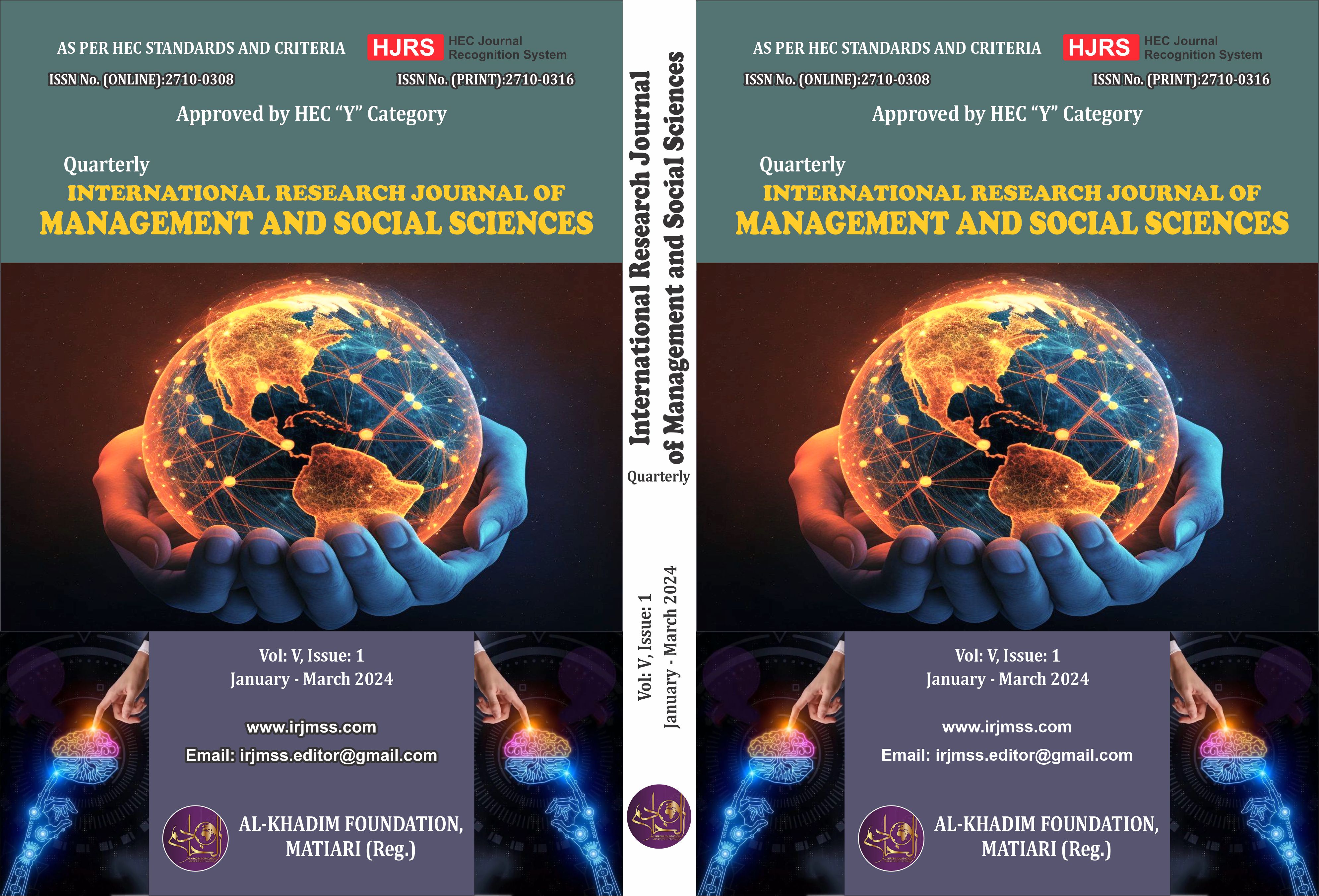Comparison of Conceptual Ability of Students Learning Through Literacy and Numeracy Drive and Traditional Method in Tehsil Gujarkhan District Rawalpindi
Keywords:
literacy, Numeracy, Teaching, Learning, understandingAbstract
This study set out to assess the success of the Literacy and Numeracy Drive (LND) in Gujar Khan District. the study aimed to compare the assessments conducted through the LND system and the traditional method. The importance of this study lies in the fact that the LND Programmed was put in place to raise the cost of education in primary schools. With the aid of quantitative and descriptive survey design, this research was completed. Gujar Khan's public elementary school teachers, who were in charge of training children in LND subjects (Urdu, English, and Mathematics) at the elementary level, made up the entire population. A process called random sampling recruited the participants in this study. 307 primary school teachers from 328 schools in the LND were selected as a representative sample to take part in the study. Using a Likert scale with five points, the survey's results were analyzed using SPSS version 24. The total population of objective 2 was taken from 327 schools. The total population of students from 327 schools was 6540. The sample of the objective 2 was scores of 364 students by Literacy and Numeracy Drive and traditional method. The instrument of the study was self-developed questionnaire. For objective 2 the scores of students by Literacy and Numeracy Drive and traditional method were taken. To analyze the data, the researcher used mean, median, mode, standard deviation and t-test. The findings of the study showed that the conceptual ability of learning of students enhanced by using traditional methods and LND. It is concluded on the basis of findings that conceptual ability of learning of students is enhanced by traditional method.
References
Blumberg, B., Cooper, D. R., & Schindler, P. S. (2014). Business Research Methods (4th ed.).
McGraw-Hill Education
Associate Professor Head of Research Center SZABIST-University Larkana - Sindh Pakistan
Banmeke, O.A., Evans, J.D., Heerman, M.C., Rodriguez-Garcia, C., Hamilton, M.C., & Chen, Y. (2019). The dynamics of deformed wing virus titer and host defensive gene expression after varroa mite parasitism in honey bees, Apis mellifera. Insects, 10(1), 16. https://doi.org/10.3390/insects10010016:contentReference[oaicite:0]{index=0}:contentReference[oaicite:1]{index=1}.
Blumberg, B., Cooper, D. R., & Schindler, P. S. (2014). Business Research Methods (4th ed.). McGraw-Hill Education.
Budiu, R. (2016). Mobile: Native Apps, Web Apps, and Hybrid Apps. Retrieved March 28, 2019.
Bybee, J. (2019). Language Change. Cambridge University Press.
Bynner, J. (2002). Literacy, Numeracy and Employability.
Campano, G. (2019). Immigrant students and literacy: Reading, writing, and remembering. Teachers College Press.
Centra, J. A., & Gaubatz, N. B. (2000). Is there gender bias in student evaluations of teaching?. Journal of Higher Education, 71(1), 17-33.
Eze, S. C., Chinedu-Eze, V., & Bello, M. O. (2018). Title of the article. Title of the Journal, Volume(Issue), Page numbers. https://doi.org/xxxx
Fawad Hussain Ghazi National Institute of Engineering and Sciences · Department of Business Administration, PhD
Haider, S. Z., & Amjad, M. (2020). More Resources, More Achievement? The Distribution of School Resources and Elementary School Students’ Achievement in Punjab. Pakistan Journal of Social Sciences, 40(2), 949-960.
Huang, R. S., Zhao, L. L., & Chen, B. Y. (2011). Quality and Guarantee: stick to the lifeline of higher education. Beijing: Science and Education Press (in China), 1-10.
Hussain, F. (2012). Still Denied Access. The Dawn.
Hussain, M. A., Iqbal, M. Z., & Akhtar, M. S. (2010). Technology based learning environment and student achievement in English as a foreign language in Pakistan. International Journal of Information and Communication Engineering, 4(1), 46-50.
Kashif, M., Cao, Y., Yuan, G., et al. (2019) Sedimentological Impact on Reservoir Quality of Es1 Sandstone of Shahejie Formation, Nanpu Sag, East China. Arabian Journal of Geosciences, 12, 545.
https://doi.org/10.1007/s12517-019-4671-y
Keefe, J. W., & Copeland, K. L. (2011). The effects of cooperative learning on student achievement in science education: A meta-analysis. Journal of Research in Science Teaching, 48(5), 550-571. https://doi.org/10.1002/tea.20416
Khattak, S. G. (2012). Assessment in schools in Pakistan. SA-eDUC, 9(2).
Leach et al. April 2019 Physical Review Letters 122(13)DOI:10.1103/PhysRevLett.122.139402
Leontiev, A. N. (2019). Activity, consciousness, and personality. (2nd ed.). Psychology Press
Makwinja, V. M. (2017). Rethinking education in Botswana: A need to overhaul the Botswana education system. Journal of International Education Research (JIER), 13(2), 45-58.
Pritchard, J. K., Stephens, M., & Donnelly, P. (2010). Inference of population structure using multilocus genotype data. Genetics, 155(2), 945-959.
Secker, J., & Shymansky, J. A. (1983). The effects of cooperative learning on the achievement and attitudes of elementary students in science. Journal of Research in Science Teaching, 20(8), 673–680. https://doi.org/10.1002/tea.3660200808
Teacher’s Job Security and Workload Factors Affecting Job Satisfaction of Teachers in Multan(Southern Punjab)–Pakistan Journal of Education and Vocational Research (ISSN 2221-2590)
Vol. 10, No. 1, pp. 1-8 June 2019
Mullola, S., Rimpelä, A., & Lintonen, T. (2011).
Mullola, S., Rimpelä, A., & Lintonen, T. (2011). The relationship between lifestyle, family structure, and health problems in adolescents. Journal of Adolescence, 34(3), 431-438. https://doi.org/10.1016/j.adolescence.2010.04.005
Velardo, V., & Drummond, J. (2017). Music, memory, and machine learning: Implications for human-computer interaction. Journal of New Music Research, 46(4), 329-340. https://doi.org/10.1080/09298215.2017.1346991
Vygotsky, L. S. (2020). Thought and Language. (Rev. ed.). MIT Press. (Original work published 1934).
Zirkel, P. A., & DuPaul, G. J. (2007). The role of school-based interventions in the prevention and treatment of attention-deficit/hyperactivity disorder. In P. S. Strain, M. J. Guralnick, & H. M. W. Davidson (Eds.), Early intervention for children with intellectual disabilities: Advances in research and practice (pp. 187-206). Springer.






